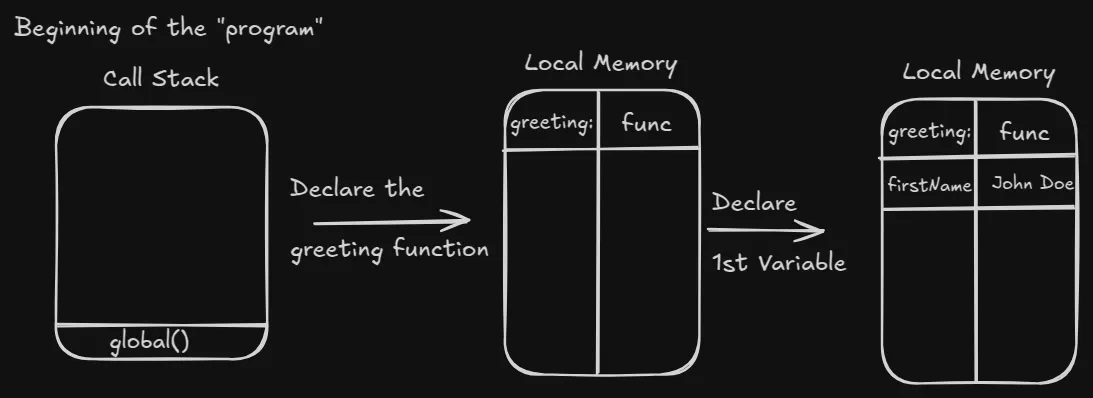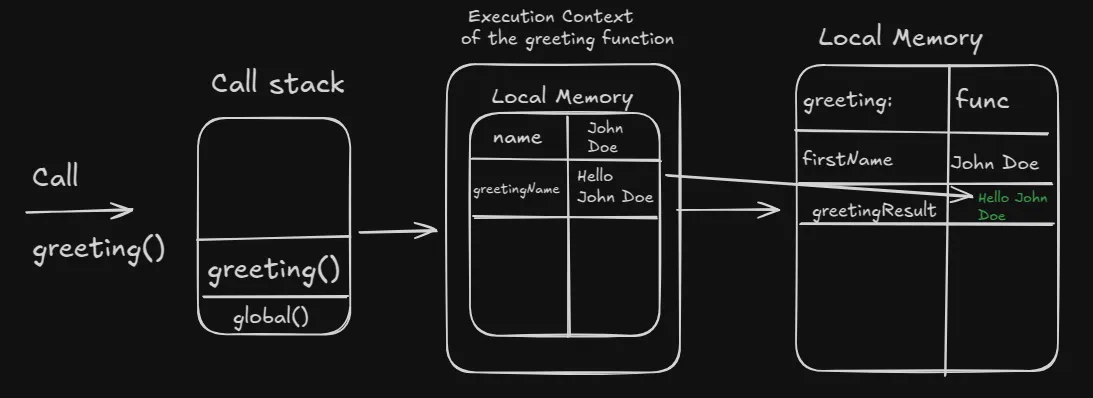Go back
How can you use HOFs to improve your DX with Javascript?
Have you ever thought about how can you use the principle of HOFs (Higher Order Functions) to help and improve your DX(Developer experience)? We are going to dig into that.
I know that you already know what HOFs are…
But I think it’s never enough to explain how functions work and what makes it a Higher Order Function
Let’s take a look into this piece of code:
function greeting(name) {
const greetingName = `Hello ${name}`;
return greetingName;
}
const firstName = "John Doe";
const greetingResult = greeting(firstName);
console.log(greetingResult);DISCLAIMER: I know that you know what are functions, but I believe that, as a developer, you should be able to explain technically how they work, not only functions but other fundamental concepts.
Since javascript is a language where it works with a single thread, the code is executed line by line, so we first declare the function but we don’t start running it, declare our firstName variable and allocate them in the local Memory

Now we declare our greetingResult and at the moment we goes inside of our unction we create a new Execution context where:
- Our greeting function enter our call stack
- We declare our argument “name”, with the value “John Doe”
- We return the new string and assign the return value to the greetingResult variable

And that’s it, this is how functions works!
Now that we know how functions work under the hood, we can define what makes a function a Higher Order Function:
- The function receive another function/callback or return another function.
Simple as that!
But how can I apply this?
You might be wondering, why do I need to understand this if I already know how to use .map() , .filter(), .reduce() and find() ? (For those who are not fafmiliar, these are some HOF from javascript )
You can use it to optimize repetitive tasks! You sometimes need to console.log() to debug something right? Or even with authorization or even for creating factory functions!
Remember this is an alternative for doing those activities, you are not “wrong” or missing something if you are not doing that.
Logging
function createLogger(level) {
const prefix = `[${level.toUpperCase()}]`;
return function (message) {
console.log(`${prefix} ${new Date().toISOString()}: ${message}`);
};
}
const logInfo = createLogger("info");
const logWarn = createLogger("warning");
const logError = createLogger("error");
logInfo("User logged in successfully.");
logWarn("API response took longer than expected.");
logError("Failed to connect to the database.");Factory a Fetcher for a base URL
function createApiFetcher(baseUrl, defaultOptions = {}) {
return async function (endpoint, options = {}) {
const url = `${baseUrl}${endpoint}`;
const fetchOptions = {
...defaultOptions,
...options,
};
console.log(`Fetching: ${url} with options:`, fetchOptions);
try {
const response = await fetch(url, fetchOptions);
if (!response.ok)
throw new Error(`HTTP error! status: ${response.status}`);
return await response.json();
} catch (error) {
logError(`API Fetch failed for ${url}: ${error.message}`);
throw error;
}
};
}
const internalApi = createApiFetcher(
"https://some-random-very-cool-api.com/v1",
{
headers: {
"X-API-Key": "SECRET_KEY",
},
},
);
async function fetchUserData() {
try {
const internalData = await internalApi("/profile/me");
logInfo(`Fetched internal profile: ${JSON.stringify(internalData)}`);
// Now you *could* process internalData further if needed
} catch (e) {
// Log the error from the fetcher OR a general error
logError(`Failed to fetch or process user data: ${e.message}`);
}
}
fetchUserData();Authorization
Here is an example using Express.js
const authorize = (requiredRoles) => {
return (req, res, next) => {
const user = req.user;
if (!user) {
return res.status(401).json({
error: "Authentication required",
});
}
const hasPermission = requiredRoles.some((role) =>
user.roles.includes(role),
);
if (!hasPermission) {
return res.status(403).json({
error: "Insufficient permissions",
});
}
next();
};
};
app.get("/users", authorize([ROLES.ADMIN]), getAllUsers);Why would I use this?
Why go beyond just using built-in HOFs like .map() and .filter() and start creating your own HOFs?
Here are some points that you might think about using it:
- Reducing Repetitive Code (DRY): Write common logic (like adding a log prefix or checking roles) once inside the HOF, not everywhere you need it.
- Making Code Clearer:: Your main code focuses on what it does (e.g., authorize([‘admin’])), hiding the how (the complex checks) inside the HOF. This makes it easier to read and understand.
- Simplifying Maintenance:: Need to change how logging or authorization works? Update the HOF in one place, not scattered across your project.
- Creating Reusable Tools: You can Build flexible HOFs (like createApiFetcher) that you can configure and reuse for different situations and repetitive tasks.
Beyond these examples, think about creating reusable HOFs for any repetitive task, like complex array manipulations tailored to your specific data needs!
And remember, there won’t be one exact way to do something in programming and you are not “wrong” on following something different!
Obviously, you need to keep in mind the trade-offs of your decision.
And this is how we can use a principle (Higher Order Functions) to create and improve our Developer experience and the developer workflow
Hope you learned something useful in this article and remember:
Drink water, eat fruits and be kind!